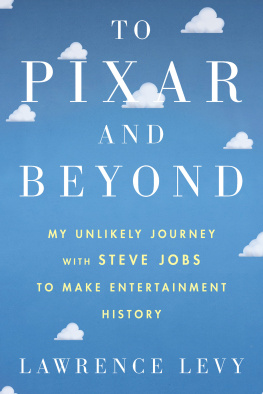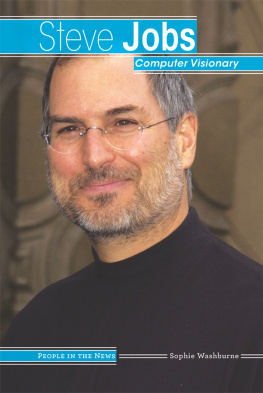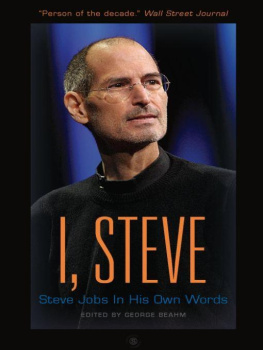Copyright 2016 by Lawrence Levy
ALL RIGHTS RESERVED
For information about permission to reproduce selections from this book, write to or to Permissions, Houghton Mifflin Harcourt Publishing Company, 3 Park Avenue, 19th Floor, New York, New York 10016.
www.hmhco.com
Library of Congress Cataloging-in-Publication Data
Names: Levy, Lawrence (Lawrence B.), author.
Title: To Pixar and beyond : my unlikely journey with Steve Jobs to make entertainment history / Lawrence Levy.
Description: Boston : Houghton Mifflin Harcourt, 2016.
Identifiers: LCCN 2016020541 (print) | LCCN 2016023332 (ebook) | ISBN 9780544734142 (hardback) | ISBN 9780544734197 (ebook)
Subjects: LCSH: Levy, Lawrence (Lawrence B.) | ExecutivesUnited StatesBiography. | Pixar (Firm)History. | BISAC: BUSINESS & ECONOMICS /Management. | BUSINESS & ECONOMICS /Entrepreneurship.
Classification: LCC PN1998.3.L4673 A32016 (print) | LCC PN1998.3.L4673 (ebook) | DDC 791.4302/3092dc23
LC record available at https://lccn.loc.gov/2016020541
COVER DESIGN BY BRIAN MOORE
e ISBN 978-0-544-73419-7
v1.1016
For Hillary, Jason, Sarah, and Jenna
Prologue
Hey, Steve, you up for a walk? I asked over the phone.
It was the fall of 2005. Steve Jobs and I had asked each other that question countless times over the past ten years. But this time was different. Steve had turned fifty earlier that year and the burden of cancer and surgery was taking its toll. For a while now we had kept our talks and walks light. Steve had enough on his hands at Apple. In the past year he had introduced a new line of iPods, including the brand-new iPod shuffle and iPod nano that continued to usher in a new era of music listening.
Today, though, I had something specific on my mind. I was on Pixars board of directors, having previously served as Pixars chief financial officer and a member of its Office of the President. I had been considering this particular matter for a while, and I felt it was time to broach it. Steve had been feeling a little better lately. This was as good a moment as any.
Sure, he said. Come on over. Im around.
We lived in Old Palo Alto, a neighborhood just a mile or two east of Stanford University in Californias Bay Area. Steves house was just a few minutes walk from mine. It sat on a corner lot, a beautiful, Tudor-style country cottage, brick walled, with a steep-sloped slate roof. I entered from the back gate and went through the kitchen door where, as was usual, an array of delicious-looking fruits and snacks sat on the long, rustic wood table. I said hello to the family chef, who was warm and welcoming, and made my way through the kitchen, down the hall, to Steves office.
Hi, Lawrence, Steve said with a smile, as he looked up and saw me.
Still up for that walk? I asked him. We can sit if you like.
Lets go for it, he said. Be nice to get some fresh air.
Walking the streets of Palo Alto was a tonic for Steve. He loved the air, the architecture, the climate. The weather was clear and warm as we strolled down the flat streets lined with oak, magnolia, and ash trees, past the variety of architectures, from small ranch houses reminiscent of an earlier era to large remodeled estates that reflected Silicon Valleys growth. After we caught up for a few minutes, I brought up what I wanted to discuss.
Id like to talk about Pixars stock price, I said.
Whats on your mind? Steve asked.
I think Pixars at a crossroads, I said. Its valuation is too high to stay still. If we have any miss, any miss at all, even a small one, Pixars value could be cut in half overnight, and half of your wealth will go with it. I paused and then added, Were flying too close to the sun.
We had enjoyed an incredible run: ten years of one blockbuster after another.
Either Pixar uses its sky-high valuation to diversify into other businesses, I went on, just like Disney did, or...
Or we sell to Disney, Steve finished my sentence.
Yes, or we sell to Disney, or anyone else that offers the same opportunity for diversifying and protecting Pixar as Disney does.
But we both knew no other company did.
Let me give it some thought, Steve replied. I hear what youre saying.
A few months later, on January 25, 2006, Pixar and the Walt Disney Company announced that Disney would acquire Pixar for a price of $7.6 billion. At that time, Steve owned the majority of Pixars stock, making his share of Pixar worth several billion dollars. Ten years later, due to the precipitous rise in Disneys value, those Disney shares almost quadrupled in value.
When I first started talking to Steve about Pixar, a little more than ten years earlier in late 1994, the company had burned through almost $50 million of his money, with little to show for it. The value assigned to Pixars stockholders on its financial statements at that time was negative $50 million. Now, Steves investment in Pixar had made him one of the wealthiest individuals in the world.
My tenure at Pixar lasted from my first conversations with Steve in 1994 until the sale to Disney in 2006. This opportunity was one of the great privileges of my life. Although much has been written about Pixars legendary creative and production processes, my side of the story looks at Pixar from a different angle. It is about the strategic and business imperatives that enabled Pixar to flourish.
It is perhaps easy to look at Pixars film accomplishments and imagine that they emerged in a blaze of creative glory, that Pixar was created as a storytelling, artistic utopia. This wasnt my experience of it. The making of Pixar was more akin to the high-pressure grinding of tectonic plates pushing up new mountains. One of those plates carried the intense pressures of innovation: the drive for artistic and creative excellence in storytelling and the invention of a new medium, computer animation, through which to express it. The other of those plates carried the real-world pressures of survival: raising money, selling movie tickets, increasing the pace of production. These two forces ground ceaselessly against each other, causing many quakes and aftershocks.
This is the story of how the little company that made the world fall in love with toys, bugs, fish, monsters, cars, superheroes, chefs, robots, and emotions emerged from the forces at work beneath it. It is about the choices and the absurd bets and risks that made it possible. It is about the tension between creative integrity and real-world necessities, and how that tension shaped those involved with itSteve Jobs; Pixars creative, technical, and production teams; and me. It is a story about what it means to put the creative impulse first, and why that is so very hard to do.
This is also a story about how, through the eyes of a two-thousand-year-old Buddhist philosophy called the Middle Way, I came to see Pixar in a larger context. How I learned that the tensions at Pixar were the very same forces that lie at the heart not just of making great films, but of living great lives, building great organizations, and freeing our inner capacities and creativity.
If I learned anything at Pixar, it is that story comes first. Pixars creative leader, John Lasseter, used to say, Great graphics will keep us entertained for a couple of minutes; it is story that holds us in our seats.
This one began with a phone call.
Lawrence Levy
March 2016
PART I
Why Would You Do That?
One afternoon in November 1994, the phone in my office rang. I was the chief financial officer and vice chairman of the board at Electronics for Imaging, a Silicon Valley company developing products for the burgeoning field of color desktop publishing. It was a clear and cool fall day in San Bruno, California, near the San Francisco airport. I picked up the phone, not knowing who it might be. The last thing I expected was to speak to a celebrity.
Next page






